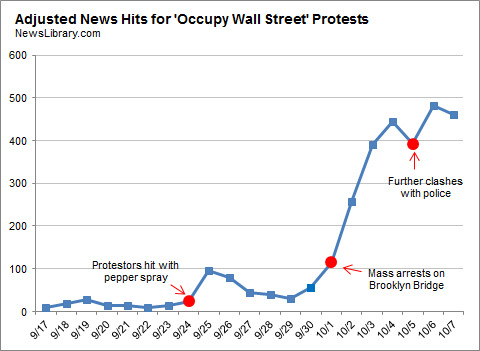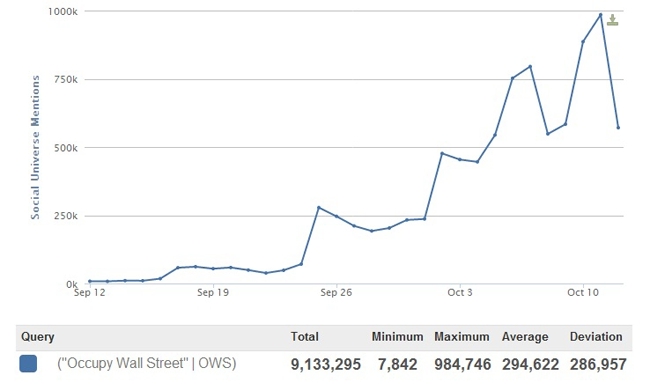Also published on HuffingtonPost
Nate Silver had a great piece in the Times over the weekend, looking at how clashes with police seem to have driven mainstream media coverage of the Occupy Wall Street protests (a classic example of the principle of “if it bleeds, it leads”). The centerpiece of his article is the chart below, showing the pattern of relevant media hits:

Nate’s article made me wonder about the comparable pattern of discussion on social media channels, a far more democratic (with a small “d”) set of media. Our new friend Steve Kleine was able to produce the social media numbers for “Occupy Wall Street” and “OWS,” hot on the heels of his first article for the site, and the results are striking:
Obviously, Twitter and the blogs increased coverage over time just as the mainstream media did, but note that they maintained a more consistent base of attention throughout — cable news and traditional journalists largely ignored the protests until something violent happened and quickly lost interest thereafter, but people talking on social channels maintained their coverage after cable news moved on. Before the police pepper-spraying, for instance, mainstream media hits numbered in the low double-digits per day, and though they spiked five-fold after those first clashes, they quickly fell again. Hits rose again after the Brooklyn Bridge arrests, but then started to drop until a new round of confrontations occurred.
By contrast, social media commentators kept a steady drumbeat of attention from the start of the protests, with each police intervention serving to boost the baseline rather than just cause a transient spike in coverage (the sudden drop after October 12 is due to a lag in the monitoring tool, not an actual decrease in hits). The social media attention curve jumps up and down, of course, but its moving average follows a much steadier upward climb over the course of the protests than the comparable graph of paid journalists’ stories.
Conclusions? Social media activists effectively had a longer attention span for the protests than the mainstream media, a great example of the internet’s ability to let individual communicators spread the word about what they care about and keep attention on an issue that the wider world is ignoring. We’ve seen this trend on Epolitics.com before, for instance during the Jena Six protests in 2007, and you can also see an analogy in how Twitter and Facebook helped to spread the word about the initial uprisings in Tunisia.
Of course, social media depend on the mainstream media to a great extent, since many blog articles, Tweets and Facebook posts center on links to websites like those of the Times or Post, but the democratization of publishing brought by the internet lets us pay attention to many, many stories that slip past traditional journalists. And I don’t think this new communications dynamic is going away anytime soon. Power to the people, baby!
– cpd


[…] from a bad review.†That’s precisely what Colin Delany, founder of Epolitics.com said in an article a few weeks back: “…cable news and traditional journalists largely ignored the protests until […]